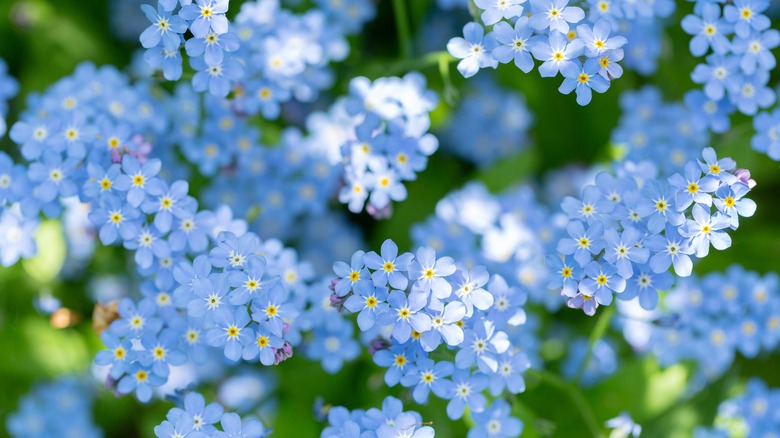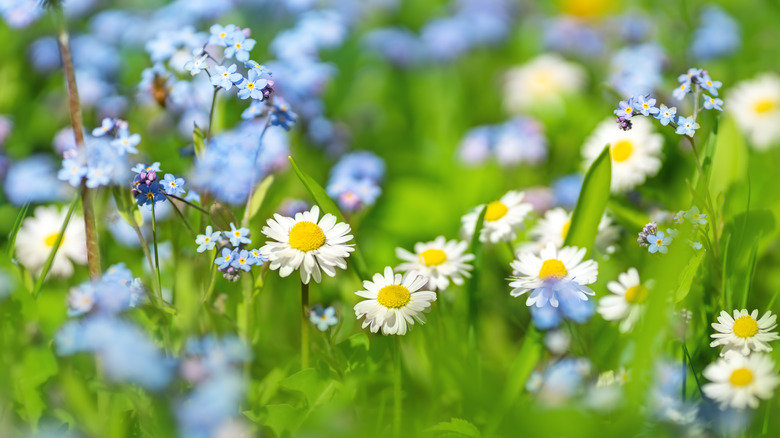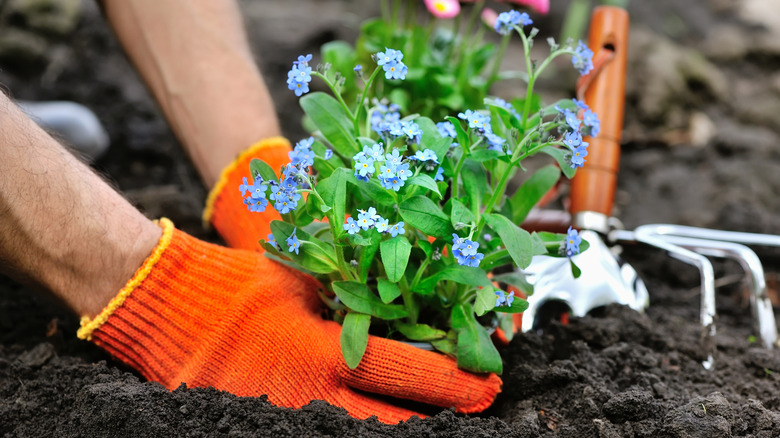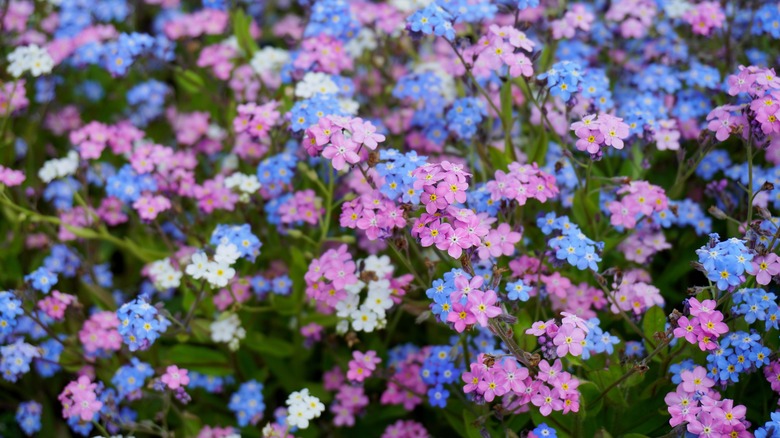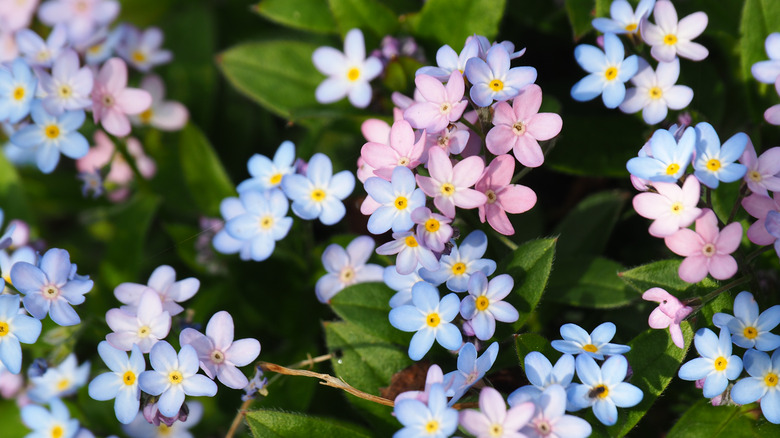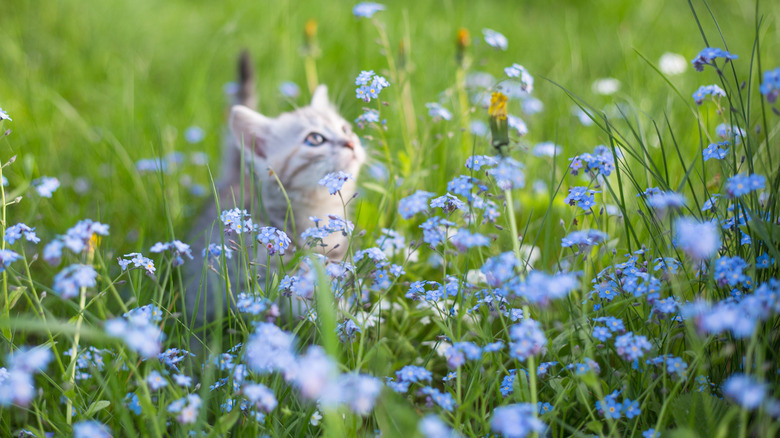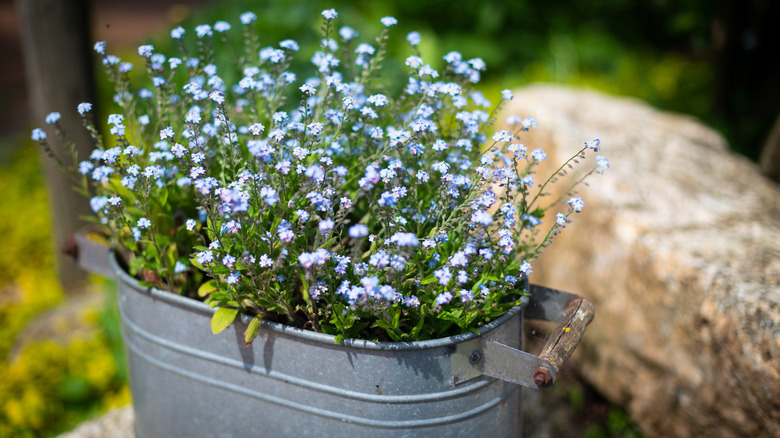How To Successfully Grow Forget-Me-Nots
Forget-me-nots, of the genus myosotis, are beautiful and dainty flowers that grow in clusters and bloom throughout the spring and summer months. Named after the Greek words mys and ous, meaning mouse ear, these plants feature five-petaled flowers in shades of blue, pink, and white, often with yellow centers. Reaching heights of a few inches to up to a foot, these flowers sprout from fuzzy stems and are often seen growing naturally near bodies of water, such as streams or ponds. Forget-me-nots attract pollinators, namely butterflies and bees, and are often used in butterfly or cottage gardens where their whimsical nature can shine.
Almanac explains that forget-me-nots can be annuals, perennials, or biennials, but growing and caring for the different types is very similar. These flowers are often used as ground cover, in hanging baskets, or to fill in space between other flowering plants. Forget-me-nots are easy to grow and care for, making them a perfect choice for beginner gardeners.
How to use forget-me-nots in garden
Forget-me-nots are adorable and whimsical plants that work well in various garden types. These plants thrive in wet and moist soil, making them perfect for use around ponds or in wetland areas where other plants may not grow. Because of their self-seeding nature, forget-me-nots also do wonderfully alongside wildflowers in cottage-style gardens that are less structured. These gardens allow the forget-me-nots to spread their seeds among other wildflowers to create a beautiful and colorful tapestry.
HGTV details that forget-me-nots can work in various places around your garden. They can be planted along the borders of your flower beds or next to footpaths. Forget-me-nots also grow well in containers, allowing you to move them around your garden as you see fit. Hanging baskets are another popular display option. These flowers are typically planted at the end of winter, and their blue coloring pairs wonderfully with other spring flowers, including tulips and daffodils.
How to grow forget-me-nots
Forget-me-nots are incredibly easy to grow, so much so that they are considered invasive in some areas. Whether you are growing an annual, biennial, or perennial variety of forget-me-nots, the growing instructions are the same. These flowers grow from seeds that can be planted directly outdoors during the summer, spaced 4 inches apart in soil, or started inside in the early spring, about two months before the last frost date.
To start your seeds indoors, add some moist soil to small pots. You can plant a handful of seeds together, lightly pushing them into the soil. Gardeners Path advises keeping the pots in a dark location and making sure the soil stays damp. Within two to three weeks, you will begin to see seedlings emerge. Once the seedlings have two sets of leaves, you can start hardening them off by placing them outside for several hours a day for about a week. Then you can plant the seedlings in the ground — just ensure the soil is loose before placing them in their holes. Finish off with a good watering. When you plant seedlings in the spring, they will flower that same growing season, while seedlings planted in the fall will bloom the following year.
How to care for forget-me-nots
Not only are forget-me-nots easy to grow, but they are also easy to care for and thrive in a variety of climates, particularly in USDA hardiness zones 3 through 8. These flowers prefer full to partial sun, although they can grow well with less light. One of the most important care tasks for forget-me-nots is watering them, explains The Spruce. These flowers are huge fans of moist soil, so watering them at least once a week, or anytime you notice a lack of moisture, is a must if you live in a dry climate. Forget-me-nots also need annual fertilizing, usually in the spring, with some compost or your fertilizer of choice.
Because forget-me-nots self-seed, they can easily and quickly take over a garden space and overcrowd your other plants. If you don't want them to spread, make sure to deadhead them as soon as their blooms begin to fade.
Forget-me-not varieties
There are dozens of species of forget-me-nots that vary in color from blue to white and pink. Forget-me-nots grow anywhere from a few inches to a foot tall and can be annuals, perennials, or biennials. Gardeners' World discusses a few varieties of this flower.
-
Myosotis scorpioides: This perennial variety of forget-me-nots has small blue flowers featuring yellow centers and can be found growing in areas with water.
-
Myosotis arvensis: These beautiful annual flowers are often seen in shades of blue or pink and have a long bloom time.
-
Myosotis 'Blue Ball': As the name implies, these forget-me-nots feature clusters of bright blue flowers.
-
Myosotis 'Bluesylva': With blooms that combine both blue and pink, these forget-me-nots are sure to stand out in your garden.
-
Myosotis alpestris 'Victoria': A truly unique variety of forget-me-nots, these flowers can be seen in stunning shades of pink, white, or blue, and last throughout the spring and summer.
Are forget-me-nots toxic?
Because there are so many variations of forget-me-nots, it is always best to research the specific type you plan on planting and whether or not it is toxic, as toxicity may vary across species. If you aren't sure which variety of forget-me-nots is in your possession, a good rule of thumb is to plant them in an area of your garden that is off-limits to your pets and children. This way, you'll avoid the risk of them consuming any potentially poisonous flowers.
Gardening Know How explains that myosotis scorpioides, a perennial species of forget-me-nots, is toxic for both pets and humans. If these flowers are accidentally consumed, they may cause severe illness, which will require immediate medical attention. Meanwhile, myosotis sylvatica, an annual variety of forget-me-nots, is non-toxic for pets and humans. This variety is often used in salads or to garnish baked treats, but may cause stomach upset if consumed in large quantities.
How to repot forget-me-nots
Since forget-me-nots grow well in containers and pots, there may come a time when you want or need to repot your flowers. According to Hunker, the perennial varieties of forget-me-nots need to be divided every few years. You'll know it's time to divide them when the plants stop producing as many flowers. Annual varieties do not need to be divided, but you can still repot them throughout the growing season if you desire.
To repot your forget-me-nots, first fill a new pot with well-draining soil and some compost or fertilizer. Then gently dig out the roots of the original plant and pull it from its old container, dividing it into smaller sections if necessary. Dig a hole in the new pot the same size as the plant's roots. You can then situate it in the hole and fill the rest of the pot with soil. After repotting, make sure to water your forget-me-nots to help them get established in their new home.
